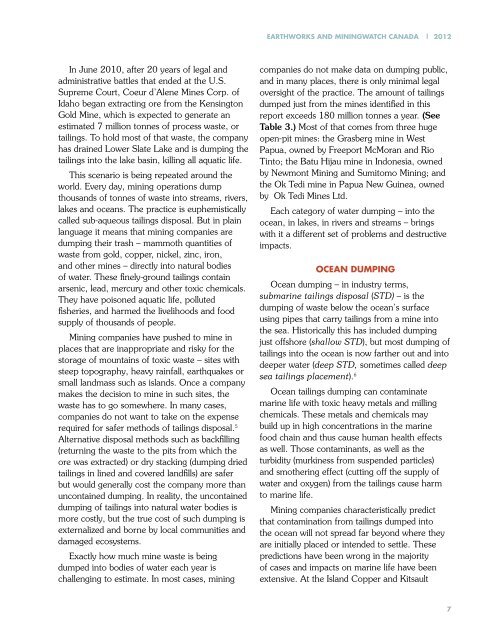Troubled-Waters_FINAL
Troubled-Waters_FINAL
Troubled-Waters_FINAL
You also want an ePaper? Increase the reach of your titles
YUMPU automatically turns print PDFs into web optimized ePapers that Google loves.
In June 2010, after 20 years of legal and<br />
administrative battles that ended at the U.S.<br />
Supreme Court, Coeur d’Alene Mines Corp. of<br />
Idaho began extracting ore from the Kensington<br />
Gold Mine, which is expected to generate an<br />
estimated 7 million tonnes of process waste, or<br />
tailings. To hold most of that waste, the company<br />
has drained Lower Slate Lake and is dumping the<br />
tailings into the lake basin, killing all aquatic life.<br />
This scenario is being repeated around the<br />
world. Every day, mining operations dump<br />
thousands of tonnes of waste into streams, rivers,<br />
lakes and oceans. The practice is euphemistically<br />
called sub-aqueous tailings disposal. But in plain<br />
language it means that mining companies are<br />
dumping their trash – mammoth quantities of<br />
waste from gold, copper, nickel, zinc, iron,<br />
and other mines – directly into natural bodies<br />
of water. These finely-ground tailings contain<br />
arsenic, lead, mercury and other toxic chemicals.<br />
They have poisoned aquatic life, polluted<br />
fisheries, and harmed the livelihoods and food<br />
supply of thousands of people.<br />
Mining companies have pushed to mine in<br />
places that are inappropriate and risky for the<br />
storage of mountains of toxic waste – sites with<br />
steep topography, heavy rainfall, earthquakes or<br />
small landmass such as islands. Once a company<br />
makes the decision to mine in such sites, the<br />
waste has to go somewhere. In many cases,<br />
companies do not want to take on the expense<br />
required for safer methods of tailings disposal. 5<br />
Alternative disposal methods such as backfilling<br />
(returning the waste to the pits from which the<br />
ore was extracted) or dry stacking (dumping dried<br />
tailings in lined and covered landfills) are safer<br />
but would generally cost the company more than<br />
uncontained dumping. In reality, the uncontained<br />
dumping of tailings into natural water bodies is<br />
more costly, but the true cost of such dumping is<br />
externalized and borne by local communities and<br />
damaged ecosystems.<br />
Exactly how much mine waste is being<br />
dumped into bodies of water each year is<br />
challenging to estimate. In most cases, mining<br />
EARTHWORkS AnD miningWATcH cAnADA | 2012<br />
companies do not make data on dumping public,<br />
and in many places, there is only minimal legal<br />
oversight of the practice. The amount of tailings<br />
dumped just from the mines identified in this<br />
report exceeds 180 million tonnes a year. (See<br />
Table 3.) Most of that comes from three huge<br />
open-pit mines: the Grasberg mine in West<br />
Papua, owned by Freeport McMoran and Rio<br />
Tinto; the Batu Hijau mine in Indonesia, owned<br />
by Newmont Mining and Sumitomo Mining; and<br />
the Ok Tedi mine in Papua New Guinea, owned<br />
by Ok Tedi Mines Ltd.<br />
Each category of water dumping – into the<br />
ocean, in lakes, in rivers and streams – brings<br />
with it a different set of problems and destructive<br />
impacts.<br />
OcEAn DUmping<br />
Ocean dumping – in industry terms,<br />
submarine tailings disposal (STD) – is the<br />
dumping of waste below the ocean’s surface<br />
using pipes that carry tailings from a mine into<br />
the sea. Historically this has included dumping<br />
just offshore (shallow STD), but most dumping of<br />
tailings into the ocean is now farther out and into<br />
deeper water (deep STD, sometimes called deep<br />
sea tailings placement). 6<br />
Ocean tailings dumping can contaminate<br />
marine life with toxic heavy metals and milling<br />
chemicals. These metals and chemicals may<br />
build up in high concentrations in the marine<br />
food chain and thus cause human health effects<br />
as well. Those contaminants, as well as the<br />
turbidity (murkiness from suspended particles)<br />
and smothering effect (cutting off the supply of<br />
water and oxygen) from the tailings cause harm<br />
to marine life.<br />
Mining companies characteristically predict<br />
that contamination from tailings dumped into<br />
the ocean will not spread far beyond where they<br />
are initially placed or intended to settle. These<br />
predictions have been wrong in the majority<br />
of cases and impacts on marine life have been<br />
extensive. At the Island Copper and Kitsault<br />
7


